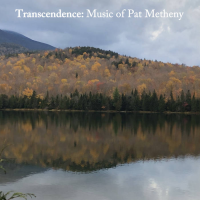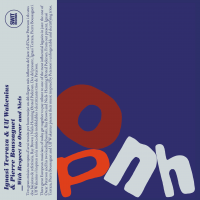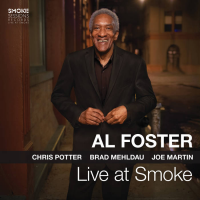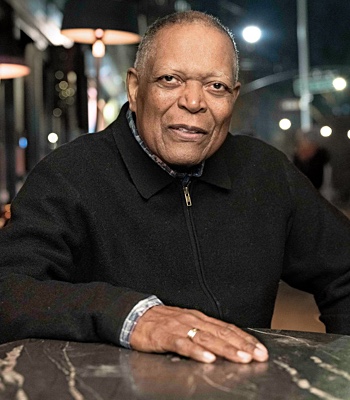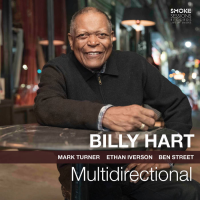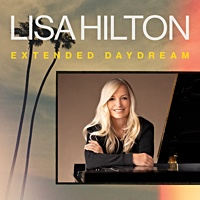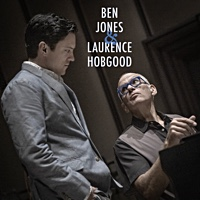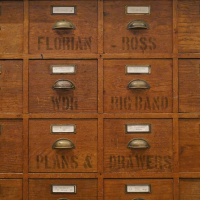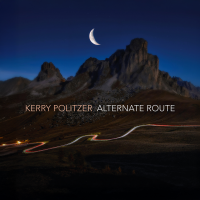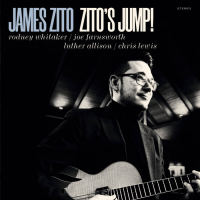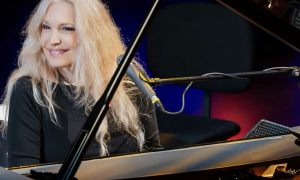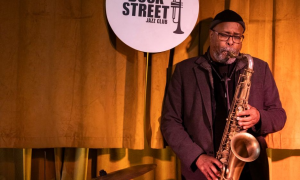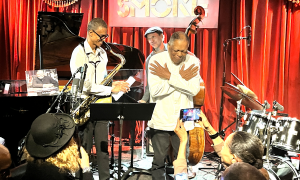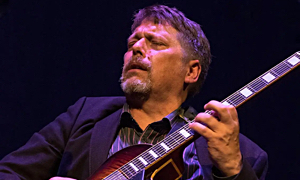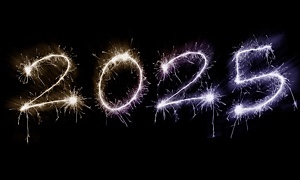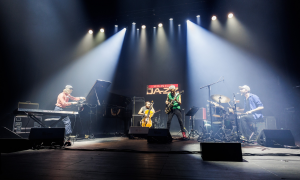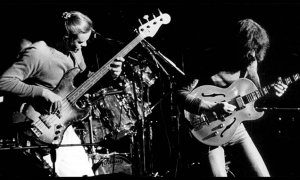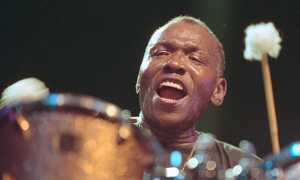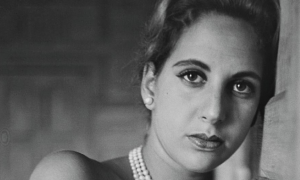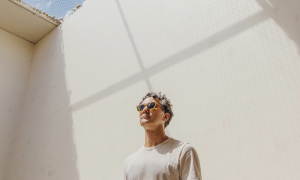Home » Jazz Articles » Live Review » Kurt Elling With Christian Sands at Miner Auditorium
Kurt Elling With Christian Sands at Miner Auditorium
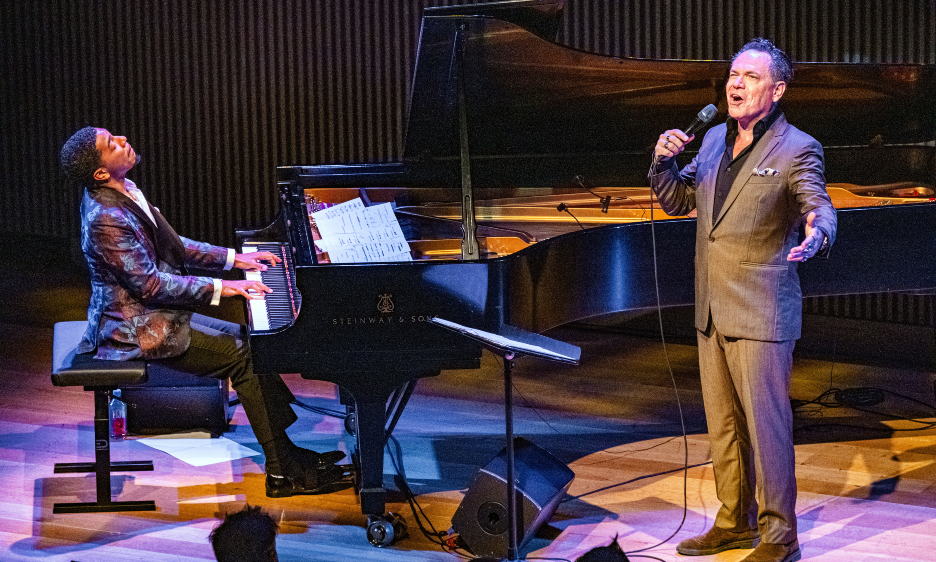
Courtesy Steve Roby
I guess it’s a remarkable time in the world—horrors and terrors and all of it. We’re going to try to feed you tonight… Jazz music has that possibility to remind us, to encourage us, to lift us, to bring us all into the same atmosphere together, and to be taking care of each other.
—Kurt Elling
Miner Auditorium (SFJAZZ Center)
San Francisco, California
October 04, 2025
A spare duo becomes an engine—voice and piano reworking Thelonious Monk, Duke Ellington, theater, and rock into a present-tense argument for hope, empathy and the living tradition of jazz.
They walked on together, and before Christian Sands reached the bench, Kurt Elling was already sketching possibilities in the air—quick scat shapes, a conspirator's grin, one hand on the piano like a hinge. The first tune, "Blue Monk," set the night's terms: the melody stated cleanly, then worried and re-angled, Elling leaning into the notes' grain while Sands answered with left-hand cells just off center, the right hand bending Monk's asymmetries into fresh corners. The choice doubled as a biography. They have just recorded the tune for Wildflowers, Vol. 3 (Big Shoulders, 2025), Elling's roaming series of fast-on-the-feet collaborations. The duo stage distilled that ethic—risk, pace, trust—into something taut and legible.
Elling's greeting framed the concert as more than repertoire. He nodded toward the world outside—"horrors and terrors and all of it"—and pledged what music could still do: "We're going to try to feed you tonight... Jazz music has that possibility to remind us, to encourage us, to lift us, to bring us all into the same atmosphere together, and to be sort of taking care of each other." It was not filler; it was a thesis. The setlist would serve as evidence.
One proof arrived through language. Elling folded a spoken prelude around "A Happy Thought," carrying poetry into song without puncturing the tune's arc. That permeability—between text and tone, literature and line—has long been Elling's province. Yet the duo format changed the physics. With only the piano beneath him, you could hear how deliberately he balances consonant and vowel, how he leans a micro-fraction behind the beat to make a single word land as meaning, not decoration. Sands kept the narrative frame, choosing voicings that clarified the poem's hush and then loosening them, as a sound editor does, when the story needed air.
Throughout the night, they treated standards as arguments rather than relics. Their Monk bent and bounced; their Ellington turned toward dawn. Introducing "I Like the Sunrise," Elling spoke of Duke's optimism—the good courage to search for light when midnight insists otherwise. Sands' spacing honored that posture: slow, patient chords opening to let the tune walk toward daybreak rather than sprint to it. Ellington's long horizon is precisely what allows this duo's short-range risk; the tradition holds that they can stretch their capabilities.
Newer material didn't announce itself as novelty. It arrived as an expansion of the ordinary book. "My Son," the lullaby from Guillermo del Toro's Pinocchio, appeared without sentimentality and therefore felt tender: Sands began with bell-like intervals close enough to suggest a whisper; Elling resisted gilding the line, trusting it to carry its own weight. The point was subtle but decisive: jazz asserts its relevance not by chasing fashion but by locating the emotional center of any worthy song and then using improvisation to reveal more of it, not less.
The night's fulcrum was a sequence that braided personal, political and theatrical threads: "Song for the Rainbow People" into Steve Winwood's "Can't Find My Way Home," then Elling's Broadway debut in Hadestown. It was not medley gymnastics so much as a statement about shared DNA—gospel hope, rock lament, theater's moral clarity—applied to the fear and noise of the moment. Elling's commentary framed it as a call to empathy and will; Sands, ever the dramatist at the keyboard, thinned textures beneath the Winwood lyric until Elling's voice stood nearly alone, then thickened them into a stage-ready swell as he nodded to Hadestown. The sequence argued not that "music will save us," but that music trains the muscle memory for listening and courage.
What made the collaboration feel necessary rather than merely enjoyable was the way each artist kept sharpening the other. Elling is a master of proportion—how close to hover before fracturing a syllable for meaning, how much grit to bring to a phrase before cleaning the line. Sands loves structure enough to test its edges. His solos unfolded like arguments: a clear premise, an exploratory counterclaim, surprise evidence, and synthesis. In third acts, a rhythmic hunch—an off-beat accent, a left-hand ostinato edging toward stride—would send him chasing a new corridor. Elling, sensing the turn, became a percussionist: consonants clicking in time, feet marking the groove, body language underlining the passage. This was not a singer "fronting" a pianist; it was a genuine dialogue where roles traded places by the chorus.
"Long As You're Living," familiar from Branford Marsalis' Upward Spiral (OKeh/Marsalis Music, 2015), carried that spirit into a blues that sounded less like consolation and more like inventory—are we doing the work, are we taking care of each other? Elling's behind-the-beat ease met Sands's churchy punctuations in a civic handshake. The encore, "When October Goes," avoided sentimental drift. Sands voiced the changes, so the fall metaphor landed as a simple fact; Elling tapered the final vowel until the room accepted silence as the only correct last chord.
Part of the evening's magnetism came from how carefully it refused triumphalism. Elling's rings—he joked elsewhere that they linger from his Broadway stint as Hermes—caught the lights like small prophecies, but the message wasn't self-mythology. It was stewardship. Monk's crooked wisdom and Ellington's sunrise weren't trophies to mount; they were tools for today's work. The duo's discipline—attend, respond, leave space—modeled a kind of civic musicianship. Even the show's pop and theater references read less as crossover than as cartography, mapping where the tradition already runs: from the sanctified church to the rock lament to the stage where narrative meets groove.
If you chart the set, you hear a quiet manifesto. Jazz, for Elling and Sands, is not a museum of perfect replicas, but it is a workshop where history is tuned to present frequencies. The songs worked because they were treated as living texts—durable enough to hold new meaning. And the duo worked because each musician respects form without mistaking it for a fence. Sands' architecture gave Elling the corridors he needed for language; Elling's textual imagination gave Sands the stakes that turn virtuosity into story.
The forward look is implied in their approach. Elling stands out as one of jazz music's most articulate modern storytellers, a singer who treats words as instruments and instruments as voices. Sands is a pianist whose mastery of tradition serves as a springboard, not a safety net. Together, they form a creative force—one that argues, gently yet firmly, that the future of the standard isn't preservation, but transformation done with care. If they keep pushing history forward at this pace, the songs we inherit will continue becoming the songs we need—sung and played by artists committed to carrying them into the weather ahead.
Setlist: "Blue Monk," "A Happy Thought," Medley: "September in the Rain"/Excerpt from On the Road by Jack Kerouac, "My Son," Medley: "Song for the Rainbow People" / "Can't Find My Way Home"/ "Hadestown" (excerpt), "I Like The Sunrise," "Long As You're Living."" Encore: "When October Goes"
Tags
PREVIOUS / NEXT
Kurt Elling Concerts
Support All About Jazz
 All About Jazz has been a pillar of jazz since 1995, championing it as an art form and, more importantly, supporting the musicians who make it. Our enduring commitment has made "AAJ" one of the most culturally important websites of its kind, read by hundreds of thousands of fans, musicians and industry figures every month.
All About Jazz has been a pillar of jazz since 1995, championing it as an art form and, more importantly, supporting the musicians who make it. Our enduring commitment has made "AAJ" one of the most culturally important websites of its kind, read by hundreds of thousands of fans, musicians and industry figures every month.



